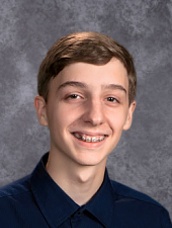This year’s essay contest was one for the books. We received 294 submissions across 15 network schools, with full participation from kindergarten to 12th grade. We learned about problems like climate change and food deserts, as well as learning to read and tie our own shoes. Each of these problems has different consequences, but the overall message rang out loud and clear – Ohio students are ready to change the world.
 School safety was a major national conversation when students were submitting essays, so it also became one of our most common topics. We landed on Timothy’s essay out of many, not because of the specific solutions, but how the students at iSTEM worked together for their school community. His government teacher, Miss Young, gave her students two full days to process after the Parkland shooting.
School safety was a major national conversation when students were submitting essays, so it also became one of our most common topics. We landed on Timothy’s essay out of many, not because of the specific solutions, but how the students at iSTEM worked together for their school community. His government teacher, Miss Young, gave her students two full days to process after the Parkland shooting.
“She introduced the topic and she was like, ‘What would help to fix this?’ And then she kinda let us go and guided us through if we were running out of topics to talk about. But she more approached it to let us talk, instead of her doing the lecturing. I think that was probably the best way to do it, because then it was our idea. We were the ones who actually wanted it to go through.”
Not everyone agreed. The class separated into two general approaches: school security and student services. When they finished the proposal, concerns from both sides were addressed.
“So it took some time… but I was very surprised by how smoothly it went. There really wasn’t any arguing. We all kind of worked together to figure out what we needed.”
Read all about the process in his essay, below.
—
Former governor of Connecticut, Jodi Rell, once said, “At the end of the day, the goals are simple: safety and security.” (Rell, 1946-present)
Recently, the problems of our nation have worried students, parents and teachers alike. In this year alone, there have been 14 school shootings (CNN, 2018). 14 shootings in 11 weeks, more than one school shooting a week. Something has changed in students, something that must be put to right. This problem had come to my government class’ attention through my history teacher. She was telling us about the current events happening, like the Florida shooting, and asked us if we had ideas how to prevent a shooting from happening at our school. This began a conversation that took two days to finish, 90 minutes of class time for each one of those days. As a class, we wrote a proposal to make our school safer. The proposal included ALICE training for students and teachers, window breakers, quality locks for the doors, rope ladders for the upper classes, and more. I helped to take votes, lead the discussion and write down what was being suggested. In the end, we finished our proposal and got 101 signatures from other students and teachers, and also presented our proposal to the principal. Already, we have seen results of our actions. The principal has set up training for all the teachers, so that they are better equipped to deal with a shooting at a school, although I hope they never have to use it. Hopefully, most of our proposal will be accepted. Nothing should be more important in a school than the safety of its students.
Unfortunately, while our proposal makes our school safer, it does not solve the problem of the school shootings. That is a much bigger and harder problem to solve. I feel that the best solution would be to provide a person to talk to, for all students. We need to provide them with someone that they can let out all their hardships and problems to, perhaps a school counselor, or a therapist. Someone that will listen to what they have to say, and help them deal with what they are feeling. These days, students have become distant with what they feel inside. It is much easier to hide what you truly feel behind a phone screen, it is far harder to hide what you feel inside your voice, face to face. Now, I cannot guarantee this solution would work. After all, the only ones that can truly stop a school shooting are the shooters themselves. The best we can do is guide them, and hope they will make the right decision.
Timothy Ziemann, 11th grader at iSTEM Geauga Early College High School
—
A special thanks to every OSLN school that participated!
| Willoughby-Eastlake School of Innovation | Northwestern Middle School |
| The Dayton Regional STEM School | Northwestern High School |
| St. Vincent de Paul | NIHF STEM Highschool |
| St. Sebastian Parish School | Metro Early College Middle School |
| St. Mary Chardon | Mahoning County Career and Technical Center |
| St. Ambrose | iSTEM Geauga Early College High School |
| Ranger Hi Tech | Dayton Regional STEM School |